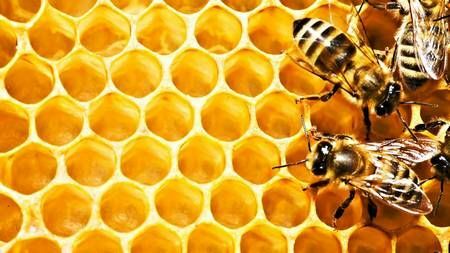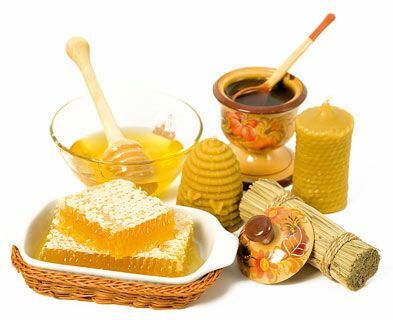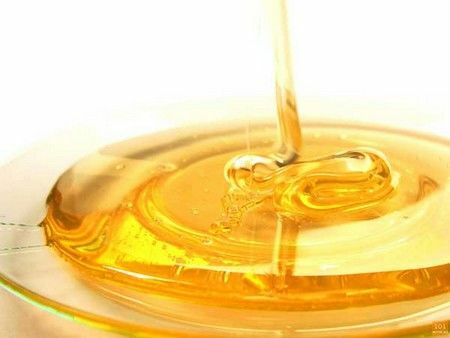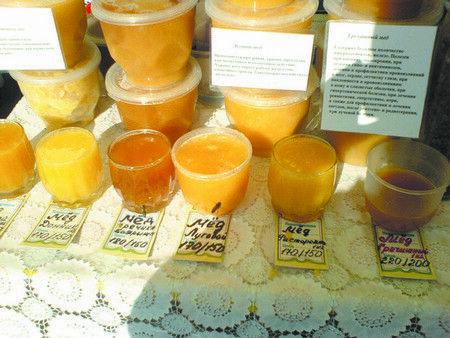- How to distinguish real honey
- Non-existent honey varieties
In this article, we'll talk about how to identify real honey from a fake. Mediators of honey - a phenomenon frequent and ubiquitous.

Faced with a reseller, you will not know, since they, as a rule, impersonate the manufacturer. Resellers can "remake" honey in order to diversify their goods and attract more buyers. However, on a par with them there are also unscrupulous producers. In this article we will also talk not only about the ways of distinguishing natural honey, but also about what sorts of it is very difficult to meet, and which does not exist and in general.
How to distinguish real honey
Let's first look at the "types" of fakes. The most "natural" of these can be real honey with various additives( for example, with the addition of essential oil to get "another grade").Also honey can be artificial and made from such products, which are not nectars from flowers.
To make "lime" beekeepers use starch, sucrose and molasses, and also use other means. Unfortunately, today honey can be forged so professionally that it will be extremely difficult to distinguish it. In particular, some "lovers"( because a real good beekeeper does not do this) prefer to feed bees with sugar syrup, and then the latter process it along with nectar. Such a product is only "recognizable" for "poor quality".
The surest way is to buy from acquaintances of beekeepers whom you know and trust. However, such is not everyone. But do not despair, there are several signs, knowing which, the ordinary buyer will be able to suspect a substandard product.
Please note: according to GOST 19792 2001, natural honey should be stored in such a way that direct sunlight does not reach it and the storage period in unsealed containers should not exceed 8 months( ie selling last year's honey, beekeepers or dealers violate these rules).
Visual indications of forgery
Let's see what can be dangerous when choosing a honey and with some probability to indicate a "lime" product.
- The price is too low. No matter how tempting it was to buy a medicinal product, cheaply think, why does the beekeeper, who spent so much effort, sell good honey "almost for nothing"?There is a big risk that, having saved, you buy only some part of the real honey, mixed with sugar syrup and tinted tea. Such a forgery really is not very easy to distinguish.
- Liquid honey. The product has a liquid consistency only for several months, then it becomes thicker. In particular, this form of healing sweetness should alert if there is winter in the yard. Hence, either the product has been diluted or heated, which is also not very good. However, it should be borne in mind that some varieties can remain in the liquid state long enough. Which ones and why? You will learn about this from the article about what honey is not candied.
 Long storage of liquid state - a sign of forgery
Long storage of liquid state - a sign of forgeryAttention: the superheated product at a temperature exceeding 50-60 degrees, loses its useful properties. Many sellers "forget" about what a real honey should be, conducting such a procedure to make honey look attractive.
- Too much white. This product, most likely, was diluted with sugar syrup.
- Too dark color, caramel taste is present. This sign indicates that the sweetness was heated or melted. Often, such a dark grade of last year's product, such as buckwheat, can be drowned and sold, saying that it is fresh.
Please note: the crystallization process is natural. If the sweetness is stored for a long time and such a process is not observed, then there is potato treacle in it or in the past it has been thermally processed. Of course, in this case, the purchase has already been made and "late to drink Borjomi", but for the future you will know what to buy from this beekeeper or from the company is not worth it.
Methods for determining
Manufacturers of "fake" product hone their skills in disguising fakes every year better and better. Let's see what else you can use the methods, if "by eye" to determine the natural honey can not.
- Method with a glass, water and iodine. Here's the first and simple method - pour a little honey into the glass, and then add a small amount of water to it. Stir. When the honey is dissolved, all additives will settle down to the bottom. If you drop a few drops of iodine into the glass and the mixture will turn blue, this will indicate the presence of starch.
- Method with a spoon. This method can be used only if the room is warm enough( about 20 degrees).Take a spoon and start wrapping honey on it, spin it quickly. If the product is natural, then it will behave like caramel - curl around the spoon and do not drain. Otherwise, the product may flow from the spoon, bubbles will appear or you will see inclusions of a different color.
- Method with blotting paper. How to determine the naturalness of honey with paper - put some honey on the paper and wait for about 5 minutes. If the back side of the paper did not appear wet spot, then honey is quality and undiluted. This is a good way at the fair - you can take honey on a disposable spoon or a stick "on trial", and then put it on paper.
- Method with fire. This method is suitable only for already crystallized honey. Set fire to a piece and watch how it burns. If the product is natural, then it will melt smoothly. The forgery will show itself a crackle and hissing( foreign components will appear).
- Method with bread. So you can check whether the sweetness is diluted with sugar syrup. Take a small piece of bread and dip it into the honey. Wait for about 10-15 minutes. Then take it out and look at it. A good and high-quality product will not soften bread, but if there is sugar water there, the bread will soften.
Advice: when making a purchase, give preference only to thick honey. A product with a clear consistency can mean that the seller warmed it up.
Non-existent honey varieties
Some beekeepers or second-hand dealers are so brilliant with imagination that they begin to invent literally honey varieties or distribute those that are incredibly rare and it is difficult to meet them at an ordinary fair. Let's see what "varieties" can also alert.
- From royal jelly. Such honey is incredibly difficult to make and almost unrealistic in such quantities, then to sell. One mother fruit contains about 200 g of milk. To make such honey, incredible efforts are needed. In most cases, a label with a loud name and incredibly useful properties, as well as a price tag with a "round" figure, is glued to a jar of white color.
- Of rose hips, poppy, corn, lupine, hazel. Despite the fact that the flowers of the plants do not have nectar, you can often find a product from a dogrose( honey mixed with a broth of wild rose? Only this one will not say).
- Chamomile honey. This name should also alert you, there is no such kind, especially on sale.
- May. In May, a professional and responsible beekeeper feeds bees with honey, which after winter only begin to build up a family. It is impossible to collect such a product for sale this month. From strawberries, blackberries, blueberries. Honey natural bees with the use of nectar from these shrubs make it very difficult to sell - they give a very meager amount of nectar, and, therefore, it is extremely difficult to make honey from it. Another thing is if bees are fed juice of berries, which they process as nectar, but this is a product of a lower quality and sellers keep silent the way of making.
- Pumpkin. It is possible to make a product from flower nectar of this plant, however, it can also be dangerous because they are treated with pesticides for pest control.
- With silvery silver. In this case, even the comments are superfluous. There is such a variety, but it turns out so little that it is not even worth talking about selling.

You should also be alerted by the mention of wild honey and too huge a choice of "flower" varieties from the seller.
Remember: always try and smell the product before buying. Do not hesitate to ask questions - when there was a collection, where the apiary is located. You pay money( and sometimes considerable), so you have every right to learn everything.
This honey has a floral aroma, sweet and pleasant( there are some varieties whose taste is quite original, but if you are going to buy such, then find out on the Internet beforehand what exactly taste and smell should be).If swallowed, it can slightly "pinch" the throat and have a slight bitterness. Look at how the houses and labs are identified in falsified counterfeiting and how even the untwisted companies
deceive consumers